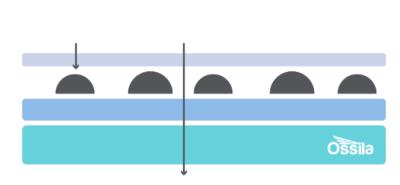Semi-transparent solar cells are appealing for many different applications such as building-integrated photovoltaics (BIPVs), tandem solar cells and in wearable electronics. Perovskites could be ideal for semi-transparent applications as they are versatile and easy to optimize.
Semi-transparent perovskite solar cells (ST-PSCs) must try to maximize efficiency and transparency. Methods such as bandgap engineering, thinning perovskite layers, and creating discontinuous structures are being developed to improve their performance. However, challenges still remain with ST-PSC development, such as phase stability and defect management.
Efficiency vs. Transparency
The obvious issue with semi-transparent solar cells is balancing efficiency with transparency. In solar cells, these factors are defined by the following metrics: power conversion efficiency (PCE) and average transparency (AVT). Increasing AVT means more light passes through the cell, reducing the light available for energy conversion. However, increasing absorption
to boost device efficiency reduces transparency [1,2].
Finding the right balance of these factors is essential, particularly for applications like BIPVs where both aesthetics and energy generation is important. An average AVT of 20-30% is needed for window applications [1]. Furthermore, opaque perovskite solar cells can achieve an efficiency of up to 29.1% PCE [3]. In theory, there is room to play with here to create a perovskite solar cell with good efficiency and transparency.
Semi-Transparent PSC Fabrication Methods
Several approaches have been developed to improve both transparency and efficiency in semi-transparent PSCs.
Band Gap Engineering
Blue shift of perovskite absorbance peak with more bromide incorporation
It is well known that by altering the composition of the perovskite material, particularly the halide ratio, researchers can tune the bandgap of perovskites. Incorporating larger halide ions into the perovskite structure, such as bromide, results in a blue shift of the absorption spectrum, allowing more visible light to pass through [1, 2]. For example, in the mixed halide perovskite MAPb(I3−xBrx) increasing the bromide content from x=0 to x=1.5 increases transparency from 10% to 24% [3].
One way to create semi-transparent PSCs is by using wide-bandgap perovskites (over 1.7 eV band gap). Wide band gap perovskites absorb less visible light than narrower band gap perovskites. This increases their transparency. Recent research has shown that WBG perovskites can offer a balance between high PCE and transparency, which is particularly useful for tandem applications [1,4].
Changing perovskite composition is one of the easiest ways to optimize your PSC performance. However, you must also factor in perovskite phase stability, as high bromide concentrations in a mixed halide perovskite can lead to phase separation. Researchers can achieve more stable perovskite formulations by incorporating cations like cesium (Cs) [1,2]. However, these materials struggle with low efficiencies and require high processing
temperatures.
Thinning Perovskite Layers
Reducing the thickness of the perovskite layer, for example by diluting the precursor solution, can also increase transparency. However, this also poses a challenge as it’s difficult to achieve thin, uniform, defect-free films. Perovskites are usually solution processed which can be easily affected by contamination. Thinner perovskite layers are prone to defects like pinholes, which can reduce device stability and performance. This can be partially overcome by processing perovskites in an environment with high contamination control, such as within a glove box. However, it is difficult to negate these defects completely. Techniques such as vacuum evaporation help form pinhole-free, ultra-thin layers that maintain performance while improving transparency [1,2].
Discontinuous Perovskite Solar Cells
Discontinuous PSCs have a non uniform perovskite layer made up of perovskite “islands” as shown below. The gaps between the perovskite islands allow visible light to pass through. One benefit of discontinuous PSCs is that this design can achieve a neutral color as opposed to uniform perovskites which will always have a reddish tint. This broadens their potential uses, especially when visual appearance is important such as in facades or skylights. While these methods improve AVT, the efficiencies of these perovskite devices are quite low. [2].
Discontinuous PSC constructed of perovskite islands. Some portions absorb light and some transmit light.
These microstructures are created through processes like dewetting and mesh-assisted deposition [2]. Dewetting is where the solvent evaporates slowly, causing the perovskite to crystallize into island-like structures. Mesh-assisted deposition uses a mesh pattern allowing selective formation of perovskite islands.
Applications of Semi-Transparent PSCs
Building-Integrated Photovoltaics (BIPVs)
Semi-transparent PSCs can be integrated into windows and facades, offering an innovative way to generate electricity while maintaining the aesthetic of a building. This is a great way to make buildings more self-sustaining. A typical requirement for window applications is an AVT of 20-30%, making it crucial to balance transparency with power output [1].
Additionally, in hotter climates a significant proportion of space heating energy is actually spent cooling spaces. Solar windows can provide shading during peak times which not only generates electricity but also reduces the amount of energy needed to maintain internal
temperatures.
Tandem Solar Cells
Tandem solar cells are created by stacking a wide-bandgap semi-transparent perovskite layer on top of a narrow-bandgap silicon solar cell. The top perovskite layer absorbs high-energy photons from the ultraviolet and parts of the visible light spectrum, while allowing lower-energy photons to pass through. These transmitted photons are then absorbed by the underlying silicon cell, which is optimized to capture visible and near-infrared light. This configuration enables each layer to specialize in absorbing different parts of the solar spectrum. By efficiently utilizing a broader range of wavelengths, this tandem setup significantly enhances the overall efficiency of the solar cell system [1,2]. As of 2024, the most efficient perovskite-silicon tandem device has a PCE of 34.6% [3].
Wearable Electronics and Screens
By integrating an extremely thin perovskite layer into displays, devices can continuously generate electricity, which helps to extend battery life and reduce the need for frequent charging. The semi-transparent nature of the material allows it to absorb certain wavelengths of light, particularly in the non-visible spectrum, while letting visible light pass through. This is ideal for smartwatches and other wearables, where space for large batteries is limited.
The Future of Semi-Transparent Perovskites
Semi-transparent perovskite solar cells represent a promising future for solar energy, particularly for applications where aesthetics and functionality are important. Potential applications include building facades and electronic displays. Despite the inherent challenges of balancing transparency and efficiency, innovative approaches like bandgap tuning, ultra-thin films, and microstructural designs are driving the development of commercially viable solutions. As research progresses, ST-PSCs could play a pivotal role in sustainable energy generation.
 Dr. Mary O'Kane is a Content Writer and Application Scientist at Ossila. She completed a PhD specializing in perovskite solar cells in 2022, and now as an Application Scientist and Content Writer at Ossila, she creates and reviews informative articles to help customers get the most out of our equipment and materials. Ossila is an international provider of advanced equipment, components, and materials to support cutting-edge scientific research and innovation worldwide.
Dr. Mary O'Kane is a Content Writer and Application Scientist at Ossila. She completed a PhD specializing in perovskite solar cells in 2022, and now as an Application Scientist and Content Writer at Ossila, she creates and reviews informative articles to help customers get the most out of our equipment and materials. Ossila is an international provider of advanced equipment, components, and materials to support cutting-edge scientific research and innovation worldwide.
References
1. Patil, P., Sangale, S. S., Kwon, S.-N., & Na, S.-I. (2023). Innovative Approaches to Semi-Transparent Perovskite Solar Cells. Nanomaterials, 13(1084).
2. Rahmany, S., & Etgar, L. (2020). Semitransparent Perovskite Solar Cells. ACS Energy Letters, 5, 1519–1531.
3. NREL Best Efficiencies Chart, (Accessed October 2024)
4. Tai, Q., & Yan, F. (2017). Emerging Semitransparent Solar Cells: Materials and Device Design. Advanced Materials, 29(34), 1700192.





